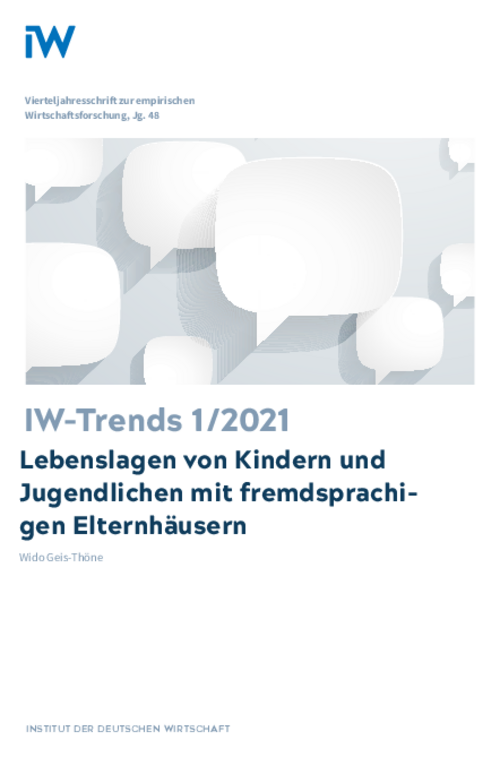An analysis of the microcensus shows that in 2017, around 2.4 million children and adolescents in Germany lived in non-German-speaking households. This corresponds to 17.7 per cent of all minors (under the age of eighteen) and 47.0 per cent of those with a migration background (defined as having at least one parent not born a German citizen).

The Social Situation of Young People from Non-German-Speaking Families
IW-Trends

An analysis of the microcensus shows that in 2017, around 2.4 million children and adolescents in Germany lived in non-German-speaking households. This corresponds to 17.7 per cent of all minors (under the age of eighteen) and 47.0 per cent of those with a migration background (defined as having at least one parent not born a German citizen).
These percentages increase almost continuously in inverse proportion to age. For example, 21.1 per cent of all children under one year of age live in a foreign-language household, more than one and a half times the proportion of seventeen-year-olds (13.5 per cent). A breakdown by federal state also reveals large regional differences. In the northern city-state of Bremen, for example, more than one in three minors lives in a foreign-language family, whereas in Thuringia, in eastern Germany, the proportion is only about one in fourteen. Households where German is not the predominant language often have relatively little formal education. 42.6 per cent of children in non-German-speaking households are not living with a parent who has a vocational qualification, compared to 17.5 per cent of children with a migration background but a German-speaking home, and 6.1 per cent of children without a migration background. This impacts negatively on these young people’s own educational careers: only 23.2 per cent of children from foreign-language households attend a more academic secondary school, compared with 38.1 per cent of children without a migration background. However, a multivariate analysis controlling for their parents’ educational background and other factors reduces this difference to only 4.4 percentage points.

Wido Geis-Thöne: Lebenslagen von Kindern und Jugendlichen mit fremdsprachigen Elternhäusern
IW-Trends

More on the topic

The Regional Distribution of Graduates in Germany
Graduates in Germany are distributed very unevenly across the country. Taking the population aged between 35 and 44, who have generally already completed their higher education, in 2019 the highest proportions of university graduates were to be found in Berlin ...
IW
The Regional Distribution of Low-skilled Workers in Germany
Low-skilled workers in Germany are heavily concentrated in urban areas. In 2019, the proportion of 25- to 64-year-olds who had not completed at least two years of vocational training or higher education was almost twice as high in cities with a population of ...
IW